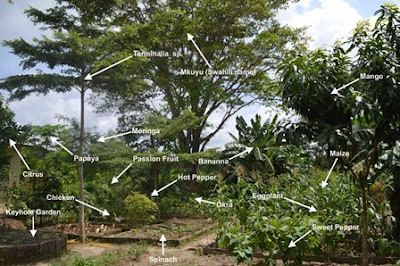PDC LESSON 2.50 DESIGN - MANDALA GARDEN
PERMACULTURE COURS AGRO-ECONOMY
PDC LESSON 2.50 DESIGN - MANDALA GARDEN
What is a mandala garden?
By definition, a mandala is
"a geometric shape or pattern symbolizing the universe; a meditation tool
for creating sacred spaces, relaxing and focusing the mind; or a symbol used as
a gateway to a spiritual journey".
Mandalas are
usually a circle containing starburst, floral,
wheel, or spiral patterns.
A mandala garden is simply a
garden with plants that adopt this design principle. Traditional mandalas were
a square containing a circle containing these patterns.
In traditional mandalas, too, the
four directions (north, east, south and west) or the four elements (earth, air,
fire and water) were often depicted in the mandala pattern.
Mandala garden
design
By building a mandala garden, you
create a sacred space for quiet reflection and meditation. As mentioned above,
mandalas are generally circular with patterns inside. Mandala gardens are also
laid out as circular gardens and the internal patterns are created by pathways
and plant beds. A simple mandala garden design can only consist of paths
running through the circle like spokes on a bicycle wheel. The wedge-shaped
beds between the spoked paths would then be filled with aesthetic and aromatic
plants.
Ideally, the plants in mandala
gardens are small and easily accessible so that each plant can be easily tended
from the pathways.
Common plants in
mandala gardens are:
Dianthus, gaura, chamomile,
catnip, lavender, yarrow, sedum, thyme, lemon balm, sage, rosemary, alyssum,
herbs of any kind make excellent additions to mandala gardens. They have also
been made with vegetables or just aesthetically pleasing plants. What you put
in your mandala garden should be based on your own preferences - which plants
make you feel happy and peaceful? These are the plants you'll want to add to a
do-it-yourself mandala garden.
DIY mandala gardens
Mandala garden design depends on
your space and budget.
Mandala gardens can be huge and
filled with intricate curved or spiral pathways. They can include a seating or
meditation area. Often large mandala gardens have a central water feature to
bring the soothing sound of rushing water into the sanctuary. There is usually
a lawn for meditating or a seating area near the water feature. Not all of us
have room for a large elaborate mandala garden.
Small mandala gardens can still
feel like a secluded, sacred space by surrounding them with tall grasses,
columnar shrubs, or evergreens. Depending on your preferences and/or budget,
mandala garden paths can be made with sand, pebbles, brick, or tile, and plant
beds can be edged with plastic edging, large rocks, brick, or concrete edging.
Plant beds can be filled with mulch or rock. You can add extra flair to wheel
pattern mandala garden designs by alternating different colours of stone and
mulch.



Comments
Post a Comment